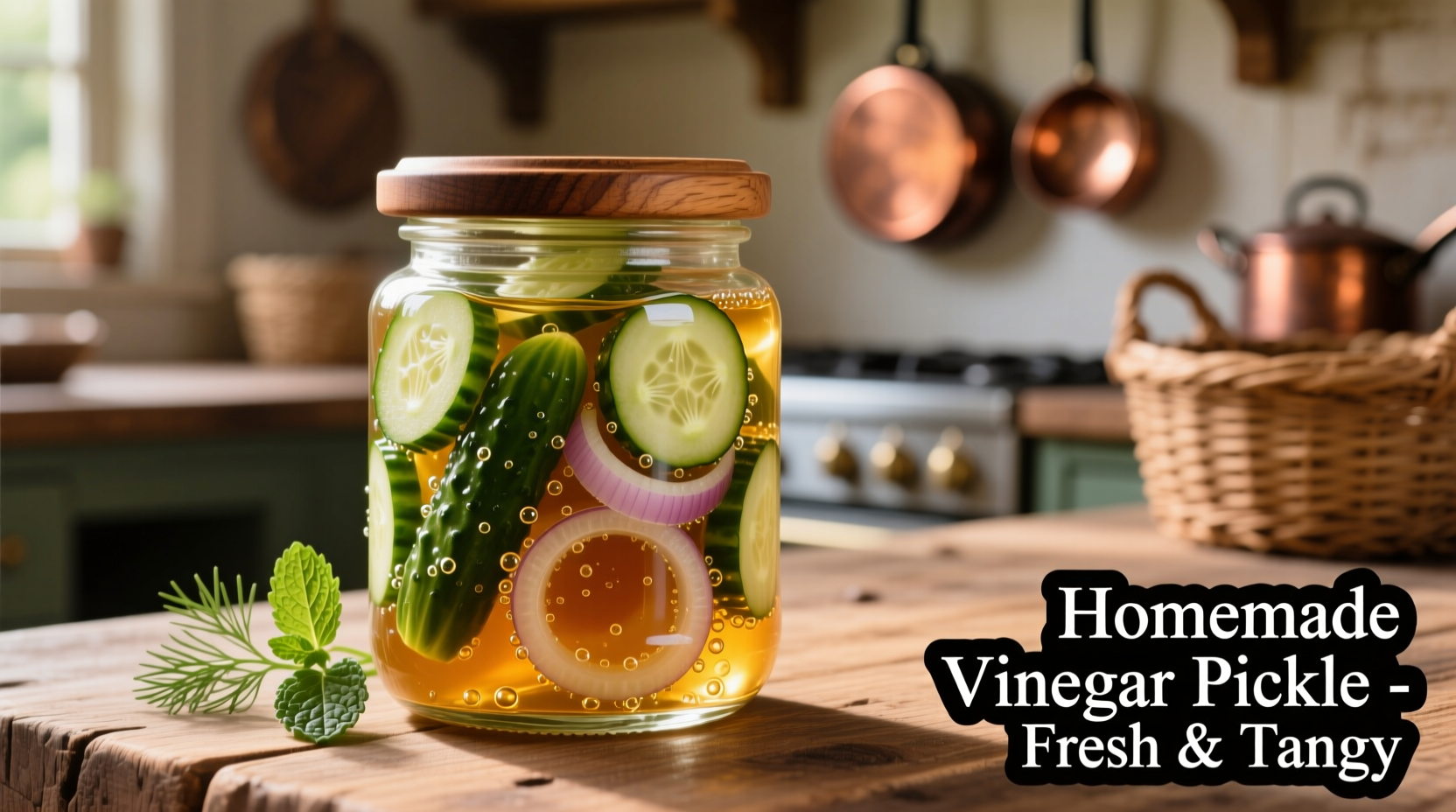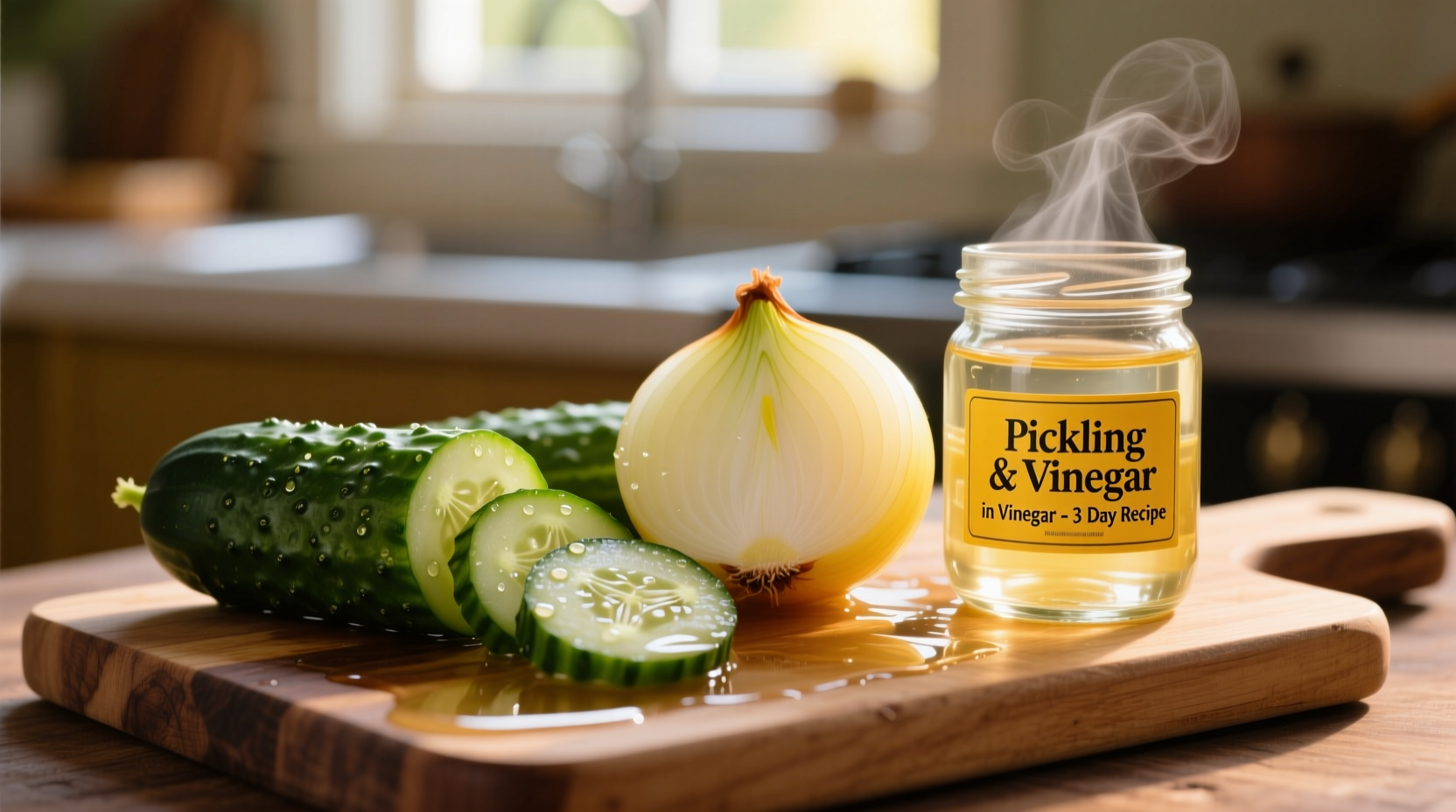Get a perfect, crisp cucumber and onion in vinegar recipe with precise measurements, step-by-step instructions, and professional tips for refrigerator pickling that requires no canning equipment. This quick pickle recipe delivers tangy, crunchy results in just 30 minutes with pantry staples.
There's nothing quite like the bright, tangy crunch of freshly pickled cucumbers and onions. This refrigerator pickle recipe skips the complicated canning process while delivering exceptional flavor and texture. Unlike many quick pickle recipes that turn soggy, our method preserves the perfect crunch through precise vinegar ratios and proper vegetable preparation.
Why This Vinegar Pickle Recipe Works
Most quick pickle recipes fail to maintain crispness because they use improper vinegar concentrations or skip critical preparation steps. Our recipe follows food science principles to ensure consistent results every time. According to the National Center for Home Food Preservation, a 1:1 ratio of vinegar to water creates the ideal acidity level for safe refrigerator pickling without compromising texture.
| Ingredient | Measurement | Preparation Notes |
|---|---|---|
| English cucumbers | 2 pounds (900g) | Sliced 1/4-inch thick, ends trimmed |
| Red onions | 1 large (200g) | Thinly sliced into half-moons |
| Distilled white vinegar | 1½ cups (360ml) | 5% acidity minimum |
| Water | 1½ cups (360ml) | Filtered preferred |
| Granulated sugar | 3 tablespoons (38g) | Can substitute honey |
| Kosher salt | 1½ tablespoons (24g) | Non-iodized for best results |
| Fresh dill | 2 sprigs | Optional but recommended |
| Garlic cloves | 2 | Smashed |
Essential Equipment Checklist
- 1-quart mason jar with airtight lid (or similar glass container)
- Medium saucepan for heating brine
- Sharp knife and cutting board
- Mandoline slicer (optional but helpful for uniform thickness)
- Slotted spoon for packing vegetables
Step-by-Step Preparation Guide
- Prepare vegetables: Slice cucumbers to uniform 1/4-inch thickness. Soak in ice water for 15 minutes to enhance crispness. Thinly slice red onions into half-moons and separate into rings.
- Create perfect brine: Combine vinegar, water, sugar, and salt in a saucepan. Bring to a gentle simmer (do not boil) until sugar and salt dissolve completely.
- Pack the jar: Place garlic cloves and dill at the bottom of your clean jar. Pack cucumbers and onions tightly but without crushing.
- Add brine: Pour warm brine over vegetables, leaving ½-inch headspace. Tap jar gently to remove air bubbles.
- Cool and store: Let cool to room temperature (about 1 hour), then seal and refrigerate.

Pro Tips for Perfect Results Every Time
Avoid these common mistakes that ruin quick pickles:
- Don't skip the ice bath: Soaking cucumbers in ice water for 15 minutes before pickling maintains crispness by strengthening cell walls. According to food science research published in the Journal of Food Chemistry, this technique preserves pectin structure.
- Never use iodized salt: Iodine causes discoloration and softening. Kosher or pickling salt maintains clarity and texture.
- Don't boil the brine: Excessive heat breaks down pectin. A gentle simmer preserves the ideal vinegar concentration.
- Wait before eating: While technically edible after 30 minutes, flavors fully develop after 24 hours. The USDA recommends waiting at least 24 hours for optimal flavor integration in refrigerator pickles.
Customization Options for Different Palates
This basic recipe adapts beautifully to various flavor profiles:
- Mexican-style: Add 1 sliced jalapeño and 1 teaspoon cumin seeds for a tangy, spicy variation perfect for tacos
- Mediterranean twist: Include 1 tablespoon dried oregano and substitute red wine vinegar for half the white vinegar
- Sweet and spicy: Increase sugar to ¼ cup and add ½ teaspoon red pepper flakes
- Herb-infused: Add fresh tarragon or dill weed for an aromatic profile
Storage Guidelines and Shelf Life
Properly stored in the refrigerator, these quick pickles maintain peak quality for 3-4 weeks. The USDA Food Safety and Inspection Service confirms that refrigerator pickles with proper acidity remain safe for consumption for up to 2 months when stored below 40°F (4°C). For best results:
- Always use clean utensils when removing pickles from the jar
- Keep vegetables fully submerged in brine
- Store in the main refrigerator compartment (not the door)
- Discard if you notice cloudiness, mold, or off odors
Perfect Pairings for Your Vinegar Pickles
These versatile pickles enhance numerous dishes:
- Add to sandwiches and burgers for a bright, acidic contrast
- Serve alongside grilled meats as a traditional Eastern European side
- Chop finely for tuna or chicken salad mix-ins
- Top avocado toast for added texture and flavor
- Include in charcuterie boards for palate cleansing
Frequently Asked Questions
Can I use apple cider vinegar instead of white vinegar?
Yes, you can substitute apple cider vinegar for white vinegar in a 1:1 ratio. This creates a slightly fruitier flavor profile while maintaining the necessary 5% acidity for safe pickling. Avoid using balsamic or wine vinegars as they lack sufficient acidity.
Why did my pickles turn out soggy?
Soggy pickles typically result from improper vegetable preparation or incorrect brine temperature. Always soak cucumbers in ice water before pickling, use non-iodized salt, and pour warm (not boiling) brine over vegetables. Overpacking the jar can also crush vegetables and compromise texture.
How long do I need to wait before eating these pickles?
While technically edible after 30 minutes, the flavors reach optimal balance after 24 hours of refrigeration. The vinegar needs time to fully penetrate the vegetables and meld with other flavors. For best results, wait at least one full day before serving.
Can I make this recipe shelf-stable without canning?
No, this refrigerator pickle recipe is not designed for shelf stability. Without proper canning pressure and time, the vinegar concentration isn't sufficient for room temperature storage. Always keep these pickles refrigerated and consume within 4 weeks for safety and quality.
What's the best cucumber variety for pickling?
English cucumbers (sometimes labeled as hothouse cucumbers) work best for refrigerator pickles due to their thin skin, minimal seeds, and firm texture. Avoid standard slicing cucumbers which contain more water and enzymes that lead to softening. Persian cucumbers also make excellent substitutes.











 浙公网安备
33010002000092号
浙公网安备
33010002000092号 浙B2-20120091-4
浙B2-20120091-4